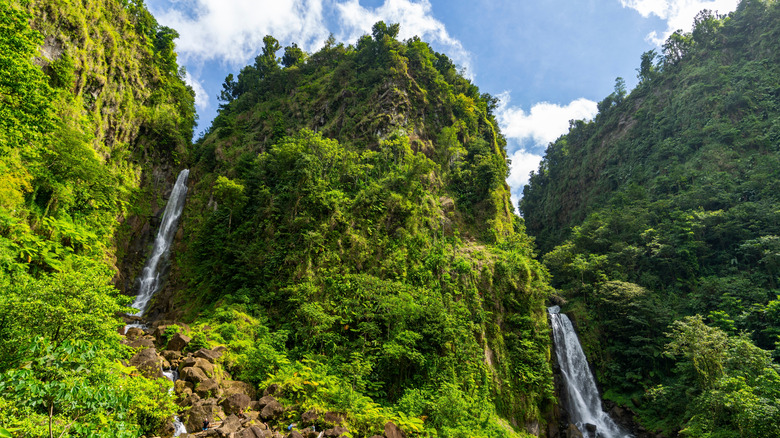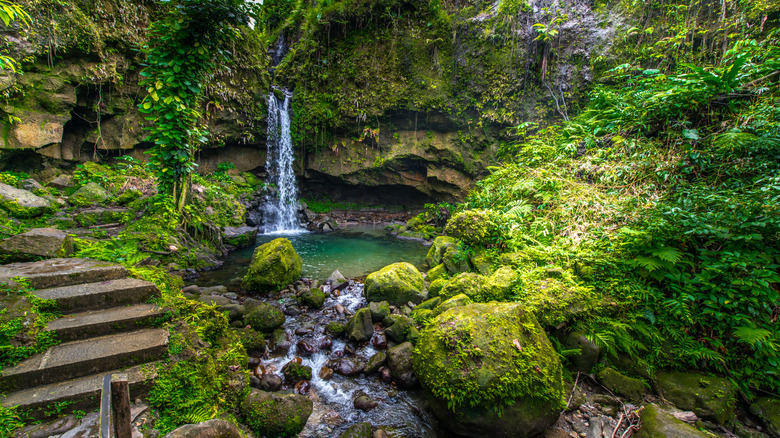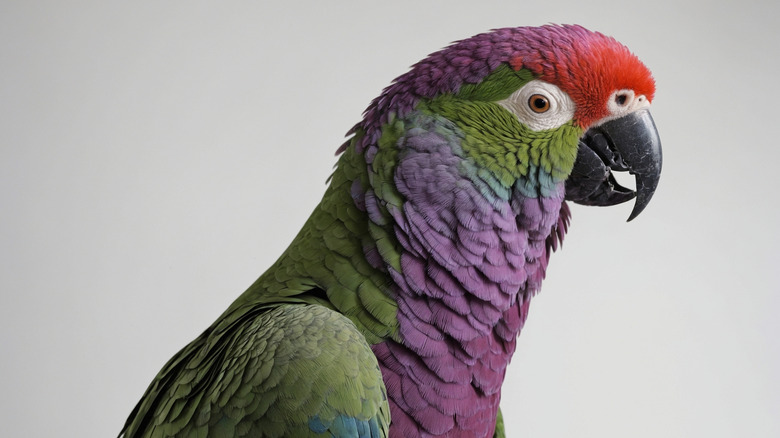The 'Relatively Undiscovered' Caribbean National Park With Unbelievably Lush Rainforests
The island nation of Dominica — not to be confused with its regional neighbor, the Dominican Republic — has a well-earned reputation for being a Caribbean island vacation getaway that won't break the bank. But beaches and sun might be among its least compelling offerings, given that the country's paradisial setting hides an otherworldly park that's as biologically and geographically diverse as it is untouched. Designated a UNESCO World Heritage Site in 1997, the Morne Trois Pitons National Park contains 7,000 hectares of tropical rainforests, freshwater lakes, dramatic valleys, and natural hot springs, all centered around the Morne Trois Pitons Volcano.
Despite the park's beauty, however, it remains largely undiscovered. Annually, the country welcomes tourists numbering in the hundreds of thousands compared to the Dominican Republic's several million, meaning you'll find a plethora of unspoiled scenery.
That isolated nature means that Morne Trois Pitons National Park is an eco-tourist's dream and a veritable playground for adventure seekers. Hiking trails cut through emerald-green jungles, geothermal features like Boiling Lake, known as one of the most dangerous in the Caribbean, dot the landscape, and the jungle that dominates the park's setting contains one of the highest levels of biodiversity in the Lesser Antilles. Put together, the park is a celebration of nature in its rawest form and a rewarding experience for travelers looking for a slice of the Caribbean that is getting increasingly more difficult to find.
Adventure in Morne Trois Pitons National Park
Morne Trois Pitons National Park is a lush space offering breathtaking natural features. The park's Boiling Lake stands out as a geothermal wonder, the second-largest such lake in the world. Its grey-blue waters bubble across the 200-foot width of its surface, heated from below by magma flows. The lake's scenery is rewarding in and of itself, featuring a view of the ocean and nearby Martinique Island. It's highly recommended that you hire a guide to safely usher you along the trails that lead to the lake, as it's one of the island's most challenging.
For a slower-paced expedition that doesn't sacrifice the natural aesthetics, visitors can head to Emerald Pool. Located on the park's northern edge just minutes from Roseau-Castle Bruce Road, the pool features a 40-foot waterfall that flows into green waters, making it a visual treat and one of the island's most-visited spots. Emerald Pool falls on Segment 5 of the country's Waitukubuli National Trail — the Caribbean's longest hiking trail.
While the island features a plethora of waterfalls hidden amongst its dense greenery, Trafalgar Falls — a pair of stunning waterfalls located near Trafalgar Village — is a true standout. Referred to as "Papa Falls" and "Mama Falls," the pair descends 125 feet and 75 feet, respectively, into a rocky basin below. The trail to the falls features a small spring that flows across it with orange-hued water, the result of iron compounds in the clay-heavy soil. Be sure to bring your camera, as the falls themselves are home to a variety of orchids and other tropical flowering plants, as well as unique bird species.
Dominica's biodiversity hotspot
One of the most richly biodiverse places in the Caribbean, Morne Trois Pitons National Park is home to a remarkable variety of flora and fauna that thrive within its borders. One of the criteria for which UNESCO highlighted the park's significance during its 1997 inscription as a World Heritage Site is the fact that it contains a range of plants, reptiles and amphibians, and birds, several of which are endemic to the country.
The park's verdant environment makes it an ideal habitat for bromeliads, a type of plant whose most well-known member is the pineapple. Orchids also populate the park, and Dominica's vibrant national flower, the Bwa Kwaib, is an endemic species whose deep scarlet flowers bloom during the dry season.
Morne Trois Pitons National Park is home to some gorgeous and unique bird species as well, including the Blue-headed Hummingbird and the Plumbeous Warbler, both of which are endemic to Dominica and a handful of its island neighbors. The Sisserou Parrot, Dominica's national bird, is potentially one of the world's oldest Amazon parrot species, and its green, blue, and dark violet coloration make it an appropriately stately and iconic animal. All of this variety makes the park a world-class destination for outdoor photographers and eco-tourists.


